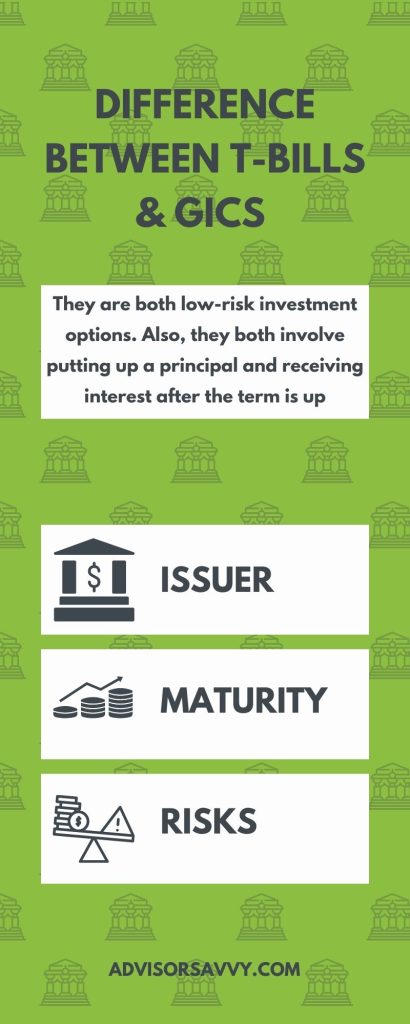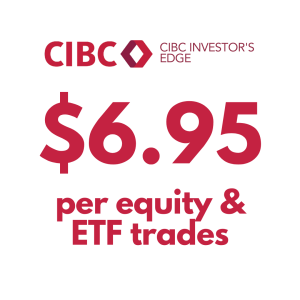
Investing in treasury bills in Canada is always a smart move, and it’s easy to tell why. These investments are backed by the credit of the Canadian government. This means both your principal and interest are guaranteed. They also offer liquidity and stability. These features make treasury bills a type of low-risk investment option.

Table of contents
- What are treasury bills in Canada?
- What is the current T-bill rate in Canada?
- What is the 10-year treasury bill rate in Canada?
- What is the difference between a GIC and a treasury bill?
- Can Canadians invest in T-bills?
- Where to Buy Treasury Bills in Canada?
- How to Buy Treasury Bills in Canada
- Are treasury bills a good investment?
If you’re considering investing in treasury bills but are not sure if you’re on the right track, we’ve got you covered! Here, we will provide an overview of treasury bills in Canada. We’ll discuss their current rates, how they compare to other investment options, and how to buy them. With this information at your fingertips, you’ll be able to determine whether they are a good fit for your investment portfolio.
CIBC Investor’s Line Offer
Up to $6.95 per online stock or ETF trade. Plus, there’s no minimum account balance.
What are treasury bills in Canada?
Treasury bills, commonly known as T-bills, are short-term debt securities. They are issued by the Canadian government to finance its operations. Essentially, when investors buy T-bills, they are lending money to the government. When the treasury bill reaches maturity, the government pays back the principal amount with interest.
T-bills have maturities ranging from a few weeks to a year, and they are sold at a discount to their face value. For example, if a T-bill with a face value of $1,000 has a discount rate of 0.5%, it will be sold for $995. The interest is the difference between the face value and the discounted price. This is what the investor earns apart from the principal amount.
One of the main benefits of investing in T-bills is their low risk. Because they are issued and backed by the Canadian government, they are considered to be virtually risk-free. As a result, T-bills are ideal for conservative investors who want to minimize their risk exposure. Of course, nothing is ever 100% risk free, but T-bills are pretty close to it!
Another benefit of T-bills is their flexibility. They are traded in the secondary market and can be bought and sold before maturity. However, if you sell your T-bills before maturity, you may receive less than the face value, depending on market conditions.
Related Reading: Budgeting Tips for Canadians
What is the current T-bill rate in Canada?
The Bank of Canada conducts regular auctions for T-bills with maturities of 1 month, 2 months, 3 months, 6 months, and 1 year. The current T-bill rate in Canada always varies depending on the term of the bill. As of April 19, 2023, T-bill rates for the following maturities are:
- 1-month T-bill rate: 4.29%
- 2-month T-bill rate: 4.36%
- 3-month T-bill rate: 4.39%
- 6-month T-bill rate: 4.55%
- 1-year T-bill rate: 4.51%
Note this data is not static. The rates are subject to change depending on various factors. Such factors include changes in the economy, monetary policy, and market conditions.

What is the 10-year treasury bill rate in Canada?
The 10-year T-bill rate in Canada is the interest rate paid on Canadian government bonds that have a maturity of 10 years. It indicates the overall health of the economy and the government’s fiscal policies. Often, it is used as a benchmark for long-term investments.
The 10-year T-bill rate in Canada is around 2.95%, as of May 2023. This rate fluctuated over the years and will continue to fluctuate. This owing to various economic and geopolitical factors, as well as changes in monetary policy by the Bank of Canada.
In general, the 10-year T-bill rate is a relatively safe long-term investment. However, investors should be wary of the returns and the fact that they may not outpace inflation. Treasury bills in Canada are a great addition to your portfolio, but it’s wise to diversify with some medium or even high risk investments.
What is the difference between a GIC and a treasury bill?
T-bills and Guaranteed Investment Certificates (GICs) are both low-risk investment options. In addition, they both involve putting up a principal and receiving interest after the term is up. Although, there are some key differences between the two that investors should be aware of. Let’s take a closer look below.
Issuer
GICs are issued by banks and other financial institutions, whereas T-bills are issued by the Canadian government. Even though both are relatively safe, T-bills are generally considered to be safer. They have the backing of the Canadian government’s credit. This makes a difference!
CIBC Investor’s Line Offer
Up to $6.95 per online stock or ETF trade. Plus, there’s no minimum account balance.
Maturity
GICs typically have longer maturities than T-bills, ranging from a few months to several years. While GICs may offer higher returns than T-bills, they also come with a higher level of risk. If interest rates rise during the term of your GIC, you may miss out on potential earnings.
In contrast, T-bills are short-term investments, with maturities ranging from a few weeks to a year. This means their overall returns may be lower than GICs. But they come with less risk, as investors can reinvest their funds at higher interest rates when the principal becomes available once again.
Associated Risks
While both T-bills and GICs can be sold before maturity, there may be penalties associated with early withdrawal. GICs typically have more stringent penalties than T-bills. This sometimes requires investors to forfeit all interest earned up to that point. However, it depends on your agreement and conditions.
Can Canadians invest in T-bills?
Yes, but there are some restrictions on who can purchase treasury bills directly from the Bank of Canada. Unfortunately, not every Canadian can invest in treasury bills.
First, investors must be at least 18 years old and have a valid Social Insurance Number (SIN). Also, investors must meet certain eligibility criteria, such as being a resident of Canada and having a Canadian bank account. Anyone who meets these criteria can invest in treasury bills in Canada.
Related Reading: Pet Financing in Canada
Where to Buy Treasury Bills in Canada?
There are several options available for Canadians who are interested in buying T-bills. Continue reading below to learn more.
The Bank of Canada
As the issuer of T-bills, the Bank of Canada is the primary source for purchasing treasury bills. Investors can participate in regular auctions held by the bank or buy T-bills directly through the bank’s buy-back program.
Remember, you must be eligible to participate in auctions or buy-back programs. Make sure you have a Canadian bank account and a valid Social Insurance Number.
Financial Institutions
Many Canadian banks and investment firms offer T-bills as part of their investment portfolios. Investors can also purchase T-bills through these institutions. This gives the investors access to their research, advice, and investment management services.
Investors should note that financial institutions may charge fees for their T-bill related services.
Online Brokerages
Online brokerages offer a convenient and low-cost way to purchase T-bills. These platforms allow investors to buy and sell T-bills through an online trading account, with low commission fees. Some popular online brokerages in Canada include Questrade, CIBC Investor’s Edge, and TD Direct Investing.
CIBC Investor’s Line Offer
Up to $6.95 per online stock or ETF trade. Plus, there’s no minimum account balance.
Discount Brokerages
Discount brokerages are another option for purchasing T-bills. These brokerages charge lower fees than traditional brokerages. However, they may not offer the same level of investment advice and management. There are several discount brokerages in Canada. They include Scotia iTRADE, BMO InvestorLine, and CIBC Investor’s Edge.
Investment Advisors
Investors who prefer a more hands-on approach to their investments can work with an investment advisor. These professionals offer personalized investment advice and management services, including access to T-bills. Their services come at a price, but a lot of the work is taken off your shoulders.
Ready to connect with an advisor? Complete this short questionnaire to get started!
How to Buy Treasury Bills in Canada
There are a few different approaches you can take to buy T-bills in Canada, as listed below.
Buying from the Bank of Canada
Buying T-Bills directly from the Bank of Canada is a bit complex and time-consuming for the average investor. You’ll be buying through the primary market. You’ll need to submit a bid to purchase the T-Bill at auction. The Bank of Canada will then allocate the T-Bill to the highest bidder.
It is note-worthy that institutional investors also participate in these auctions. Individual investors may find it daunting to compete with them. This is a major drawback to this approach. However, seasoned investors may be interested in partaking in the process!
Buying Already-Issued Canadian T-bills
This approach is done through the secondary market. It is a more practical option for most investors. Most brokerage accounts offer this option through their online platforms or over the phone. It can be a more convenient way to purchase T-Bills than participating in the primary market auctions.
To buy T-bills on the secondary market, you will need to open a brokerage account if you don’t already have one. Once you have an account, you can place an order to purchase T-bills through the brokerage’s trading platform. You will need to specify the type of T-bill you want to purchase, the amount you want to invest, and the maturity date.
When you buy T-bills on the secondary market, you are essentially buying them from another investor who already owns them. The price you pay for the T-bill will depend on market conditions and the prevailing interest rates at the time of purchase.
Pooled Investments
This entails investing in treasury bills through a pooled investment such as an ETF or mutual fund. It is the easiest and most diversified way to invest in T-Bills. T-Bill ETFs or mutual funds typically invest in a variety of T-Bills with different maturities. With this approach, investors are provided with a diversified portfolio of T-Bills. This option is attractive for investors who do not have the time or expertise to manage a portfolio of individual T-Bills.
Related Reading: How to Buy Stocks
Are treasury bills a good investment?
Whether T-bills are a good investment depends on your individual financial goals and risk tolerance. Here are some factors to consider when evaluating T-bills as an investment:
Low Risk
T-bills are considered to be one of the safest investments available, as they are backed by the credit of the Canadian government. They offer a low-risk way to invest your money and preserve your capital. This makes them an attractive option for conservative investors.
Low Yield
While T-bills are low-risk, they also offer relatively low yields compared to other types of investments. Investors can expect to earn only a modest return on their investment. In addition, the returns may not outpace inflation which means you might be better off investing your money elsewhere. However, as a short term investment, treasury bills can still be worthwhile.
Short-Term
T-bills are short-term investments, typically ranging from 1 month to 2 years. This means they are not suitable for investors who are looking for long-term growth. Plus, if you’re looking to get a steady stream of income from investments, you will need to check out other options.
Liquidity
T-bills are highly liquid, which means they can be easily bought and sold in the secondary market. This makes them a good option for investors who need access to their money quickly or who want to take advantage of changing market conditions.
T-bills are a valuable investment option. If you prioritize capital preservation and low-risk investments, then go for it! But before investing in T-bills, evaluate your individual financial goals and risk tolerance. Consider factors such as your investment timeline, liquidity needs, and overall portfolio and risk diversification. Do these before deciding whether T-bills are an appropriate investment for your situation. Also, research properly to ensure you are purchasing T-bills from a reputable source and at a fair price. By taking a thoughtful and informed approach to invest in T-bills, you can achieve your financial goals!
Read More: How to Invest $1000, $10,000 or $100,000

